Spatio-Temporal Fish Catch Assessments Using Fishing Vessel Trajectories and Coastal Fish Landing Data from around Jeju Island
Abstract
:1. Introduction
2. Materials and Methods
2.1. Characteristics of the Fishery in the Study Area
2.2. Fishing Vessel Trajectory and Fish Landing Data Aggregation
2.3. Fishing and Non-Fishing Activity Identification
2.4. Spatio-Temporal Distribution of Fish Catches
2.5. Estimation of Spatio-Temporal Distribution of Fish Catch Data
3. Results
3.1. Mapping Spatio-Temporal Distribution of Catch
3.2. Assessment of Fish Resource and Vessel/Gear Activity Distribution
4. Discussion
Supplementary Materials
Author Contributions
Funding
Conflicts of Interest
References
- Cohen, P.J.; Allison, E.H.; Andrew, N.L.; Cinner, J.; Evans, L.S.; Fabinyi, M.; Garces, L.R.; Hall, S.J.; Hicks, C.C.; Hughes, T.P.; et al. Securing a just space for small-scale fisheries in the blue economy. Front. Mar. Sci. 2019, 6, 171. [Google Scholar] [CrossRef]
- Kroodsma, D.A.; Mayorga, J.; Hochberg, T.; Miller, N.A.; Boerder, K.; Ferretti, F.; Wilson, A.; Bergman, B.; White, T.D.; Block, B.A.; et al. Tracking the global footprint of fisheries. Science 2018, 359, 904–908. [Google Scholar] [CrossRef] [PubMed] [Green Version]
- Park, J.H. Korea’s Fisheries Sector Assessment; Simon Yoon, WWF-Korea: Seoul, Korea, 2016. [Google Scholar]
- Jung, S.; Ha, S.; Na, H. Multi-decadal changes in fish communities Jeju Island in relation to climate change. Korean J. Fish. Aquat. Sci. 2013, 46, 186–194. [Google Scholar] [CrossRef]
- Jeong, B.K. A study on the protection plan of fisheries resources against illegal Chinese fishing vessels. J. Korean Soc. Fish. Mar. Sci. Educ. 2016, 28, 1549–1560. [Google Scholar]
- Seo, M.S.; Kim, I.P. A study on the illegal fishery at the Korean Central and Southern coasts of the yellow sea. J. Korean Soc. Fish. Mar. Sci. Educ. 2005, 17, 170–179. [Google Scholar]
- International Telecommunication Union. Recommendation itu-r m.1371-3. Technical Characteristics for an Automatic Identification System Using Time Division Multiple Access in the VHF Maritime Mobile Band. 2014. Available online: http://www.itu.int/ (accessed on 23 March 2021).
- Adibi, P.; Pranovi, F.; Raffaetà, A.; Russo, E.; Silvestri, C.; Simeoni, M.; Soares, A.; Matwin, S. Predicting fishing effort and catch using semantic trajectories and machine learning. In International Workshop on Multiple-Aspect Analysis of Semantic Trajectories; Springer: Cham, Switzerland, 2019; pp. 83–99. [Google Scholar]
- Witt, M.J.; Godley, B.J. A step towards seascape scale conservation: Using Vessel Monitoring Systems (VMS) to map fishing activity. PLoS ONE 2007, 2, e1111. [Google Scholar] [CrossRef] [PubMed] [Green Version]
- Lee, J.; South, A.B.; Jennings, S. Developing reliable, repeatable, and accessible methods to provide high-resolution estimates of fishing-effort distributions from vessel monitoring system (VMS) data. ICES J. Mar. Sci. 2010, 67, 1260–1271. [Google Scholar] [CrossRef] [Green Version]
- Russo, T.; D’andrea, L.; Parisi, A.; Martinelli, M.; Belardinelli, A.; Boccoli, F.; Cignini, I.; Tordoni, M.; Cataudella, S. Assessing the fishing footprint using data integrated from different tracking devices: Issues and opportunities. Ecol. Indic. 2016, 69, 818–827. [Google Scholar] [CrossRef]
- Natale, F.; Gibin, M.; Alessandrini, A.; Vespe, M.; Paulrud, A. Mapping fishing effort through AIS data. PLoS ONE 2015, 10, e0130746. [Google Scholar] [CrossRef] [Green Version]
- Campbell, M.S.; Stehfest, K.M.; Votier, S.C.; Hall-Spencer, J.M. Mapping fisheries for marine spatial planning: Gear-specific vessel monitoring system (VMS), marine conservation and offshore renewable energy. Mar. Policy 2014, 45, 293–300. [Google Scholar] [CrossRef]
- Hinz, H.; Murray, L.G.; Lambert, G.I.; Hiddink, J.G.; Kaiser, M.J. Confidentiality overfishing effort data threatens science and management progress. Fish Fish. 2013, 14, 110–117. [Google Scholar] [CrossRef]
- Kim, K.I.; Lee, C.; Ahn, J. The fishing grounds and frequency of appearance of Chinese fishing vessels obtained by analyzing AIS data in the south coast of Jeju Island. J. Korean Soc. Fish. Technol. 2019, 55, 356–362. [Google Scholar] [CrossRef]
- Skauen, A.N. Quantifying the tracking capability of space-based AIS systems. Adv. Space Res. 2016, 57, 527–542. [Google Scholar] [CrossRef] [Green Version]
- de Souza, E.N.; Boerder, K.; Matwin, S.; Worm, B. Improving fishing pattern detection from satellite AIS using data mining and machine learning. PLoS ONE 2016, 11, e0158248. [Google Scholar]
- Kim, K.I.; Lee, K.M. Convolutional Neural Network-Based Gear Type Identification from Automatic Identification System Trajectory Data. Appl. Sci. 2020, 10, 4010. [Google Scholar] [CrossRef]
- Kim, J.T.; Rho, H.G.; Kim, S.H. Studies on the forming mechanism of the fishing ground of yellow tail, Seriola quinqueradiata, in the adjacent sea of Jeju island. Bull. Kor. Soc. Fish. Tech. 2002, 38, 20–35. [Google Scholar]
- International Maritime Organization (IMO). Guidelines for the Onboard Operational Use of Shipborne Automatic Identification Systems (AIS); Res A.917; International Maritime Organization (IMO): London, UK, 2002. [Google Scholar]
- Marzuki, M.I. VMS Data Analyses and Modeling for the Monitoring and Surveillance of Indonesian Fisheries. Ph.D. Thesis, Universite bretagne Loire, Rennes, France, 2017. [Google Scholar]
- Ferrà, C.; Tassetti, A.N.; Grati, F.; Pellini, G.; Polidori, P.; Scarcella, G.; Fabi, G. Mapping change in bottom trawling activity in the Mediterranean Sea through AIS data. Mar. Policy 2018, 94, 275–281. [Google Scholar] [CrossRef]
- Cha, B.Y.; Kim, B.Y.; Oh, S.W. Catch variation and fishing period of the set net fishery in coastal waters of Jeju Island. Korean J. Ichthyol. 2001, 13, 210–219. [Google Scholar]
- Ko, J.C.; Kim, J.T.; Kim, S.H.; Rho, H.K. Fluctuation Characteristics of Temperature and Salinity in Coastal Waters around Jeju Island, Korea. J. Fish. Soc. 2003, 36, 306–316. [Google Scholar]
- Cha, B.Y.; Chang, D.S.; Kim, B.Y. Seasonal variation of fish catch by a set net in Hamdeuk fishing ground off Jeju Island. Korean J. Fish. Aquat. Sci. 2004, 37, 65–72. [Google Scholar]
- Kim, M.J.; Han, S.H.; Kim, J.S.; Kim, B.Y.; Song, C.B. Species composition and bimonthly changes of fish community in the coastal waters of Sagyeoi, Jeju Island. Korean J. Ich-Thyol. 2014, 26, 212–221. [Google Scholar]
- Noh, J.; Ryu, J.; Lee, D.; Khim, J.S. Distribution characteristics of the fish assemblages to varying environmental conditions in artificial reefs of the Jeju Island, Korea. Mar. Pollut. Bull. 2017, 118, 388–396. [Google Scholar] [CrossRef] [PubMed]
- Kim, K.I.; Ahn, J.Y. A study on appearance frequencies and fishing ground exploration of low-run fishing obtained by analyzing AIS data of vessels in the sea around Jeju Island. J Korean Soc. Fish. Ocean Technol. 2018, 54, 157–163. [Google Scholar] [CrossRef]
- Chang, D.S.; Yoo, J.T.; Kim, B.Y.; Lee, S.J.; Kwon, D.H.; Koo, J.H.; Ahn, J.M.; Oh, I.Y. Acharacteristics on the forming of fishing ground and population ecological study of Yellowtail, Seriola quinqueradiata, in the coastal waters off Gim-nyeong of Jeju Island, Korea. Korean J. Fish. Technol. 2010, 46, 406–415. [Google Scholar] [CrossRef] [Green Version]
- James, M.; Mendo, T.; Jones, E.L.; Orr, K.; McKnight, A.; Thompson, J. AIS data to inform small scale fisheries management and marine spatial planning. Mar. Policy 2018, 91, 113–121. [Google Scholar] [CrossRef] [Green Version]



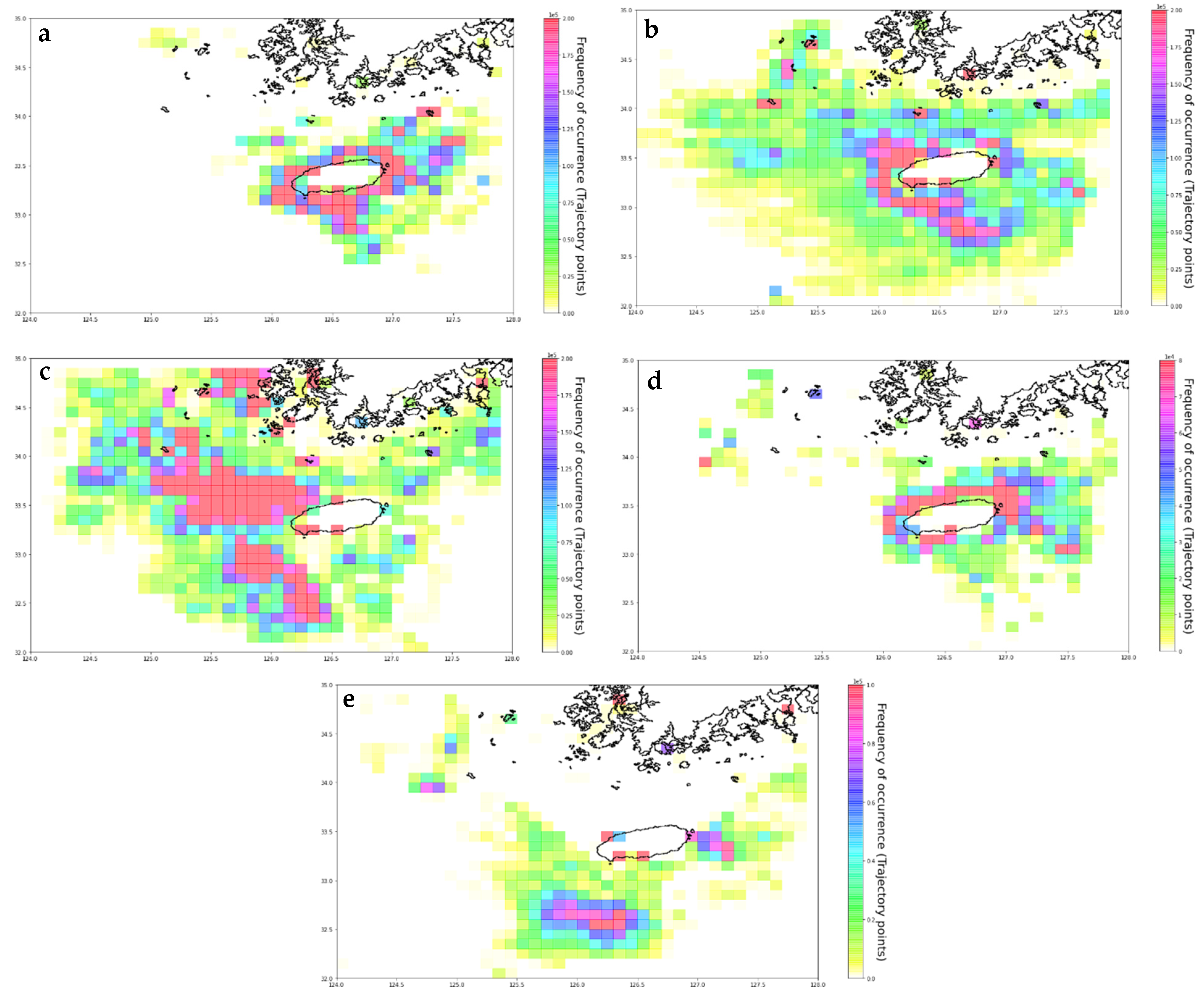
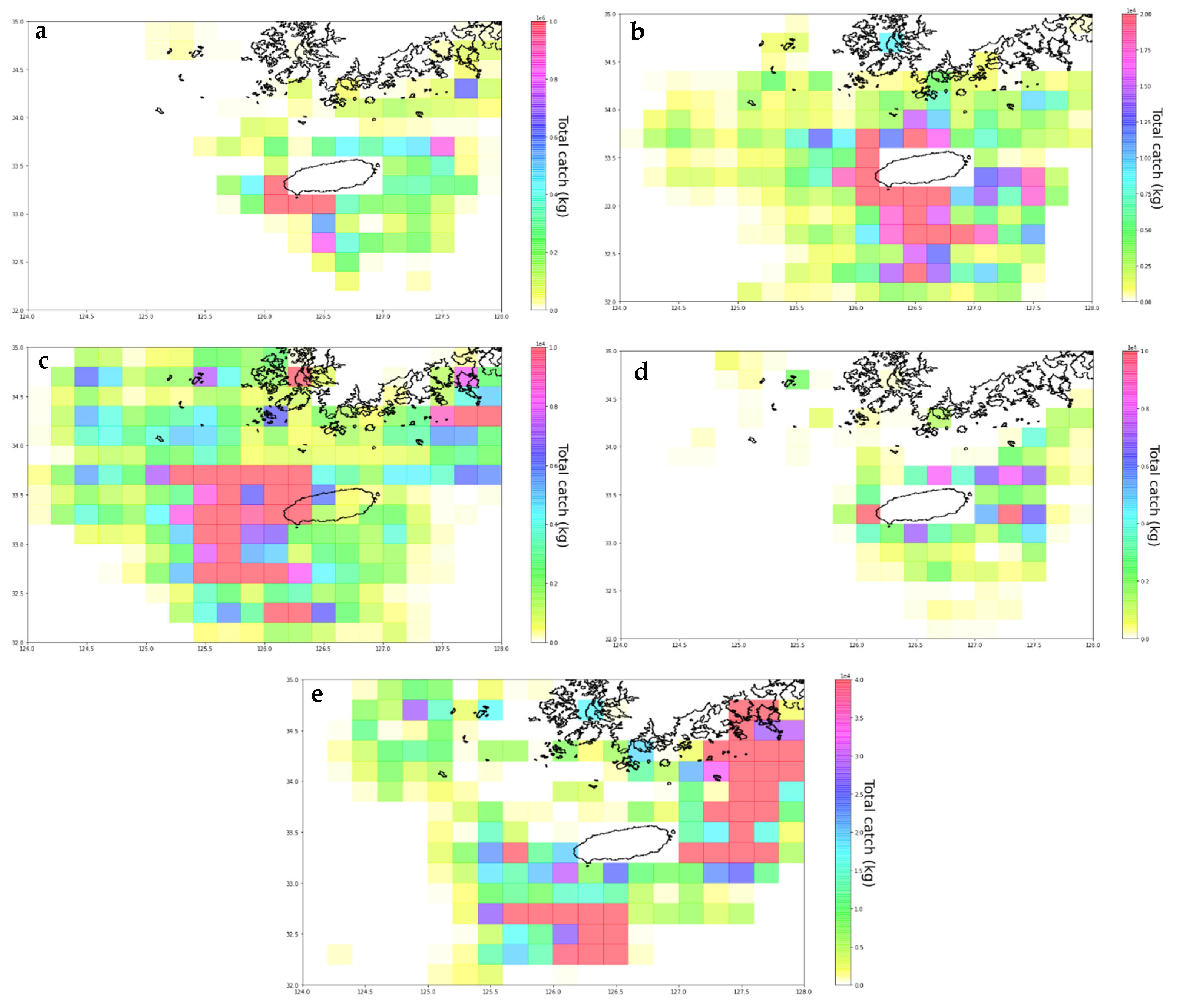
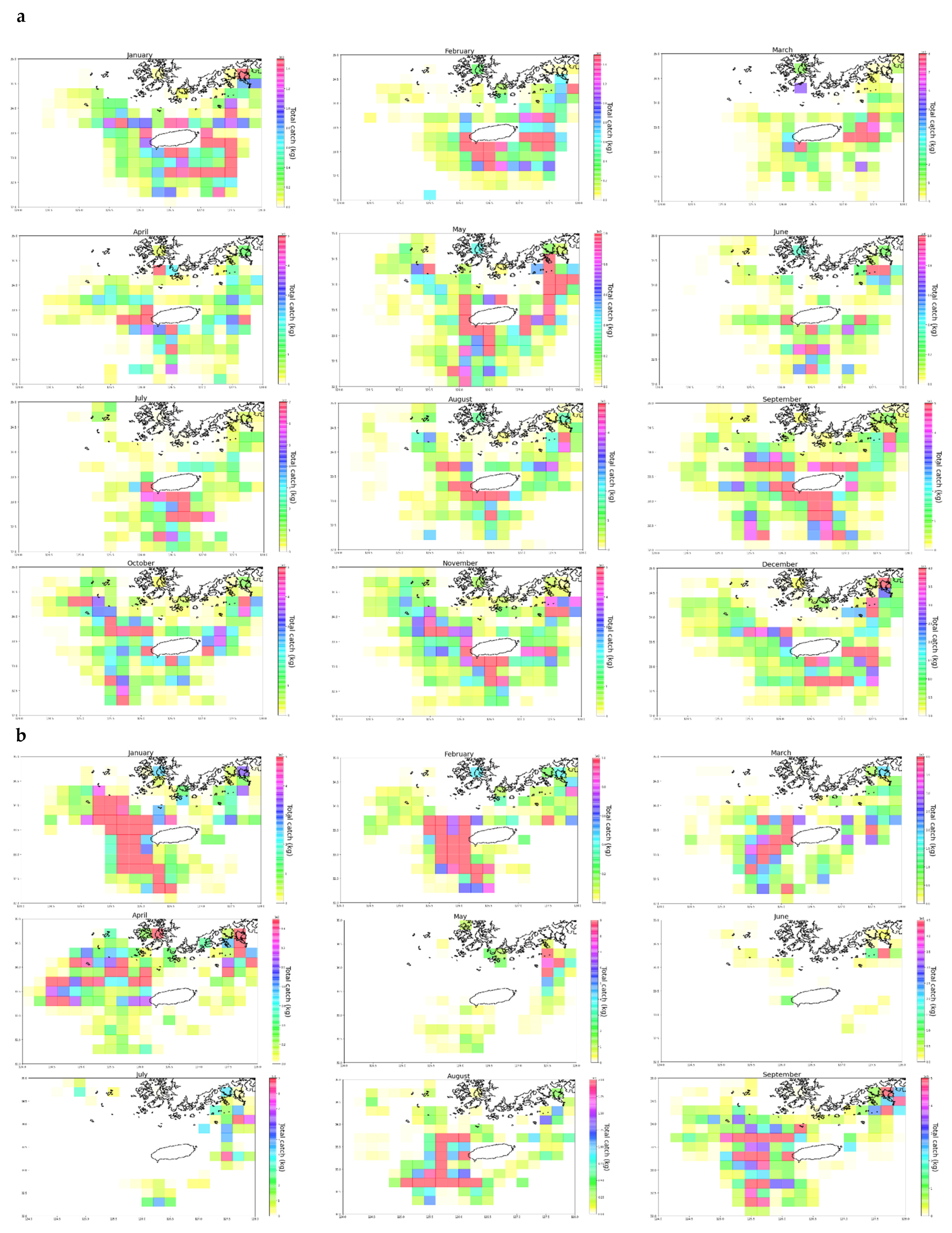
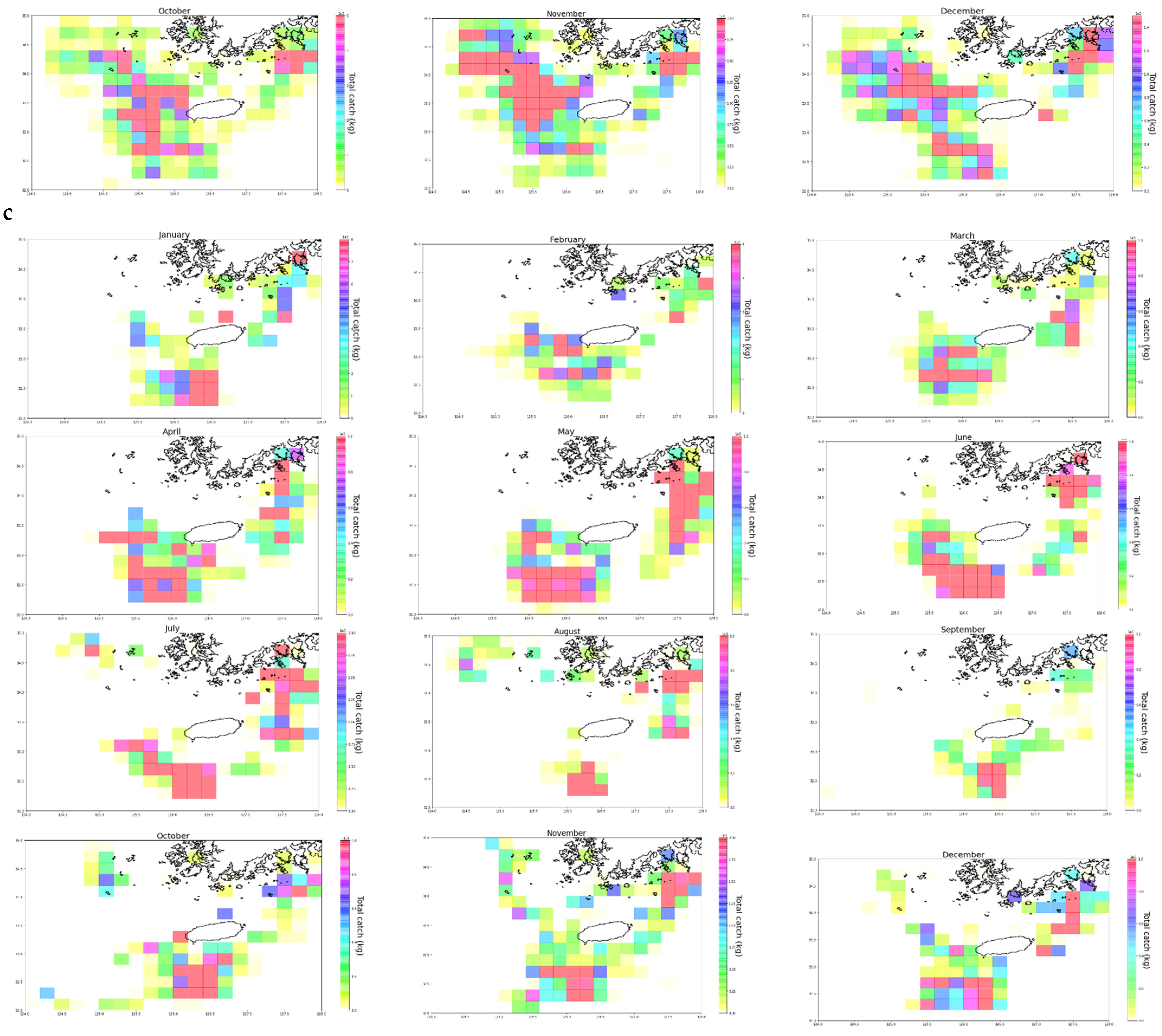
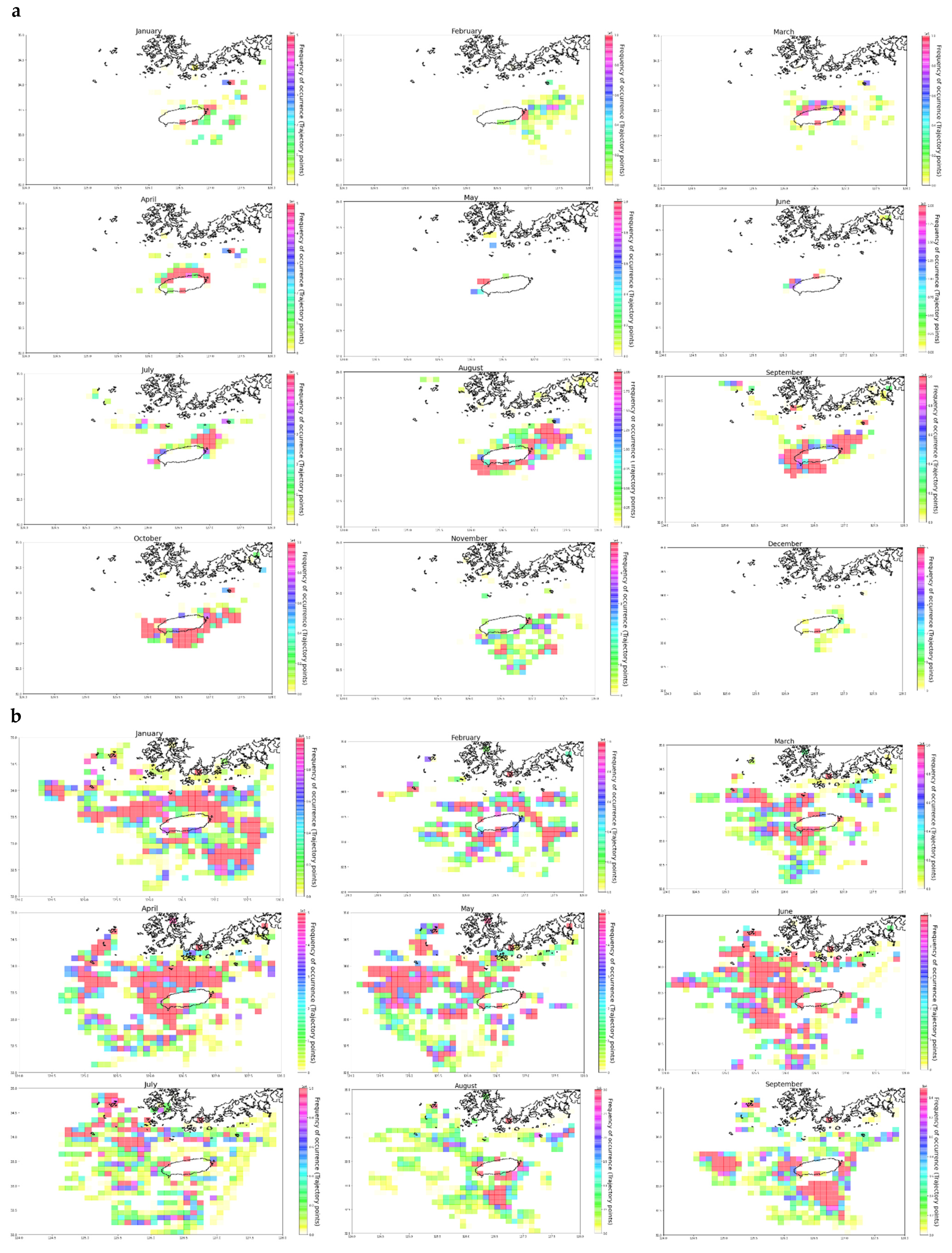
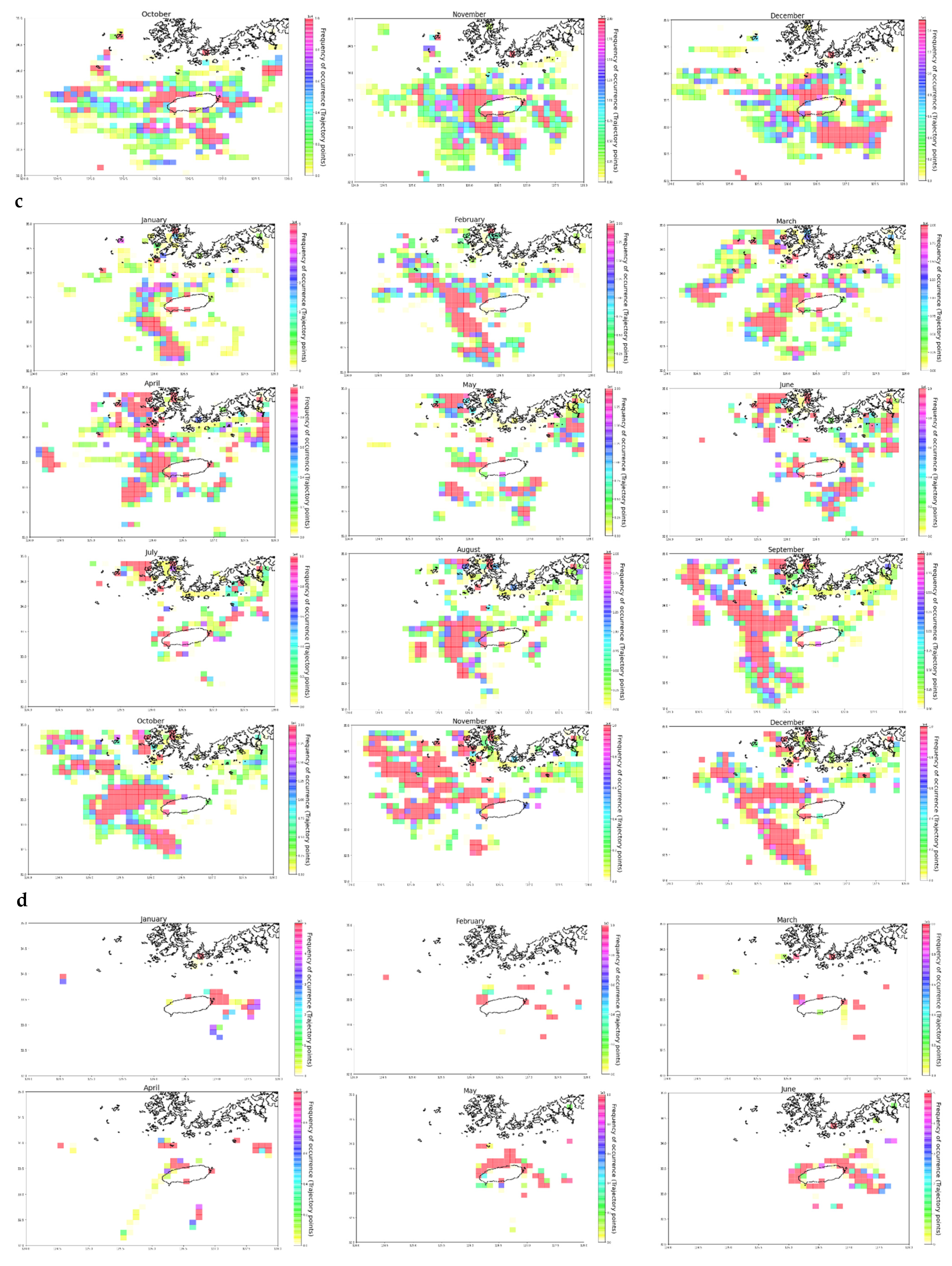
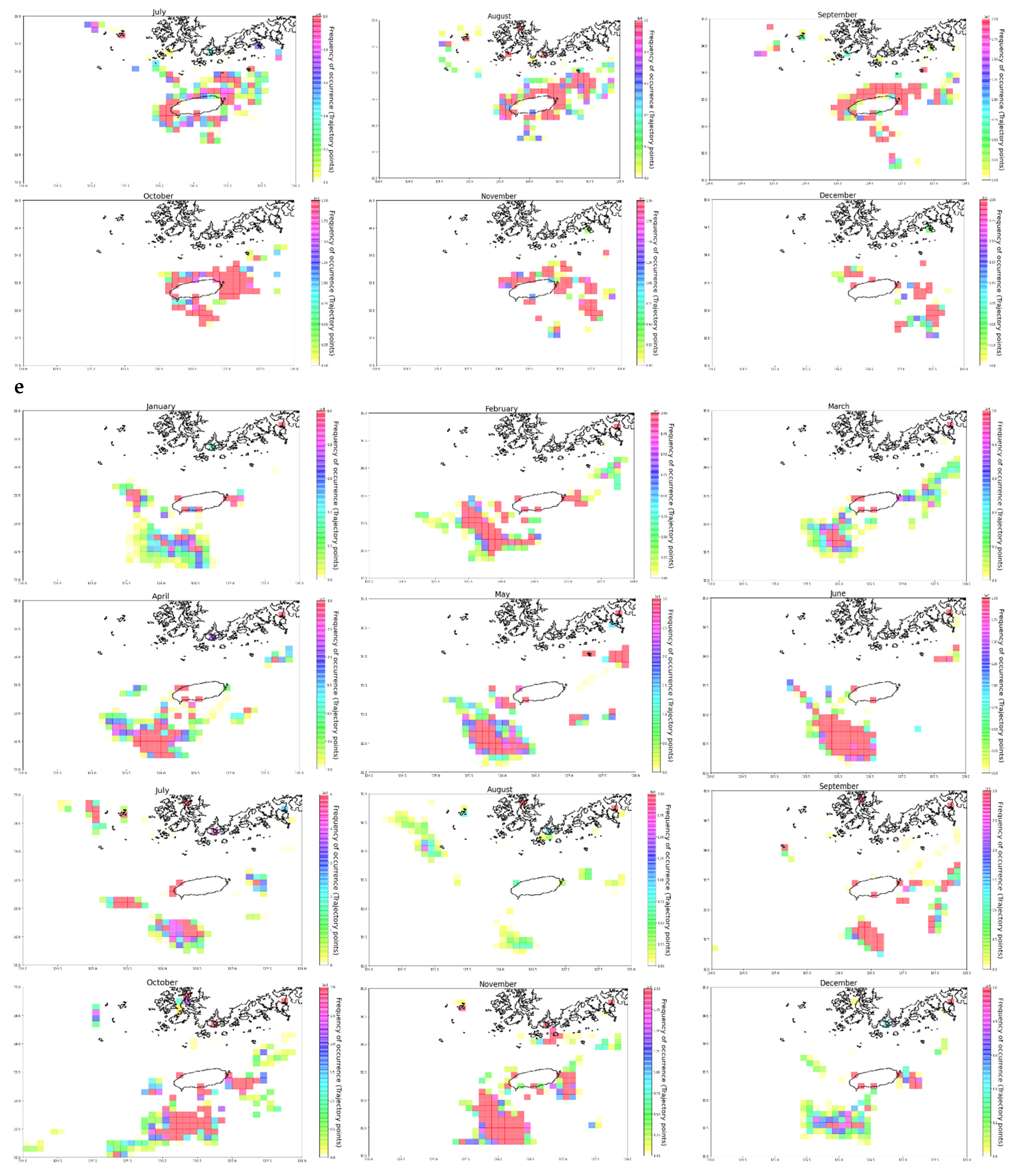
| Date Time | MMSI † | Fishing Ship Type | Latitude | Longitude | Fish Species | Amount (kg) |
|---|---|---|---|---|---|---|
| 13 February 2013 21:14 | 440 | squid jigging fishing | 33.5 | 126.2 | Anglerfish | 7.9 |
| 13 February 2013 21:14 | 440 | squid jigging fishing | 33.5 | 126.2 | Halibut | 12.1 |
| 13 February 2013 21:14 | 440 | squid jigging fishing | 33.5 | 126.2 | Others | 61.5 |
| 13 February 2013 21:14 | 440 | squid jigging fishing | 33.5 | 126.2 | Halibut | 38.9 |
| 13 February 2013 21:14 | 440 | Gillnet | 33.5 | 126.2 | Perch | 21.3 |
| 13 February 2013 21:14 | 440 | Gillnet | 33.5 | 126.2 | Croaker | 76.9 |
| 13 Februray 2013 21:14 | 440 | Gillnet | 33.5 | 126.2 | Jacopever | 1.2 |
| 13 February 2013 21:14 | 440 | Gillnet | 33.5 | 126.2 | Ray | 0.6 |
| 13 February 2013 21:14 | 440 | Purse Seine | 33.5 | 126.2 | Mackerel | 115.2 |
| 13 February 2013 21:14 | 440 | Gillnet | 33.5 | 126.2 | Croaker | 342.6 |
| 13 February 2013 21:14 | 440 | Purse Seine | 33.5 | 126.2 | Sea eel | 31.8 |
| 13 February 2013 21:14 | 440 | Gillnet | 33.5 | 126.2 | Tile fish | 75.3 |
Publisher’s Note: MDPI stays neutral with regard to jurisdictional claims in published maps and institutional affiliations. |
© 2021 by the authors. Licensee MDPI, Basel, Switzerland. This article is an open access article distributed under the terms and conditions of the Creative Commons Attribution (CC BY) license (https://creativecommons.org/licenses/by/4.0/).
Share and Cite
Owiredu, S.A.; Kim, K.-I. Spatio-Temporal Fish Catch Assessments Using Fishing Vessel Trajectories and Coastal Fish Landing Data from around Jeju Island. Sustainability 2021, 13, 13841. https://doi.org/10.3390/su132413841
Owiredu SA, Kim K-I. Spatio-Temporal Fish Catch Assessments Using Fishing Vessel Trajectories and Coastal Fish Landing Data from around Jeju Island. Sustainability. 2021; 13(24):13841. https://doi.org/10.3390/su132413841
Chicago/Turabian StyleOwiredu, Solomon Amoah, and Kwang-Il Kim. 2021. "Spatio-Temporal Fish Catch Assessments Using Fishing Vessel Trajectories and Coastal Fish Landing Data from around Jeju Island" Sustainability 13, no. 24: 13841. https://doi.org/10.3390/su132413841






